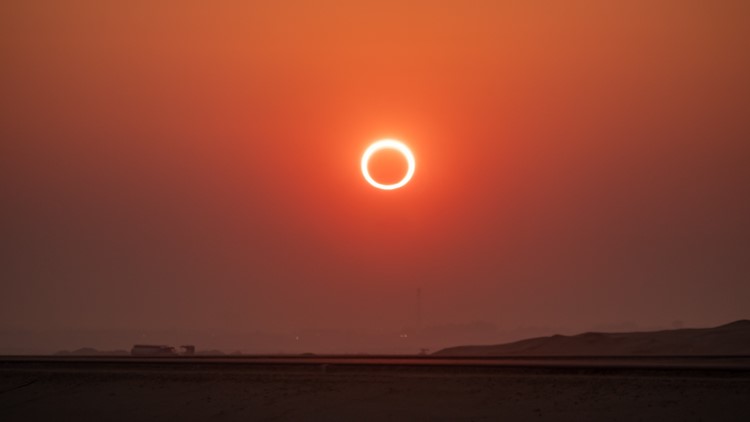Millions of Americans will have a front-row seat to the rare “ring of fire” eclipse of the sun on Saturday, Oct. 14, 2023. The annular solar eclipse — better known as a “ring of fire” — will briefly dim the skies over parts of the western U.S. and Central and South America.
As the moon lines up precisely between Earth and the sun, it will blot out all but the sun’s outer rim. A bright, blazing border will appear around the moon for as much as five minutes, wowing skygazers along a narrow path stretching from Oregon to Brazil.
The celestial showstopper will also yield a partial eclipse across the rest of the Western Hemisphere. It’s a prelude to the total solar eclipse that will sweep across Mexico, the eastern half of the U.S. and Canada on April 8, 2024.
It’s exciting to watch these rare events, but looking directly into the sun can damage your eyes. We’re VERIFYING four ways to safely watch the “ring of fire” solar eclipse.
THE SOURCES
- NASA
- American Astronomical Society
- The Exploratorium, a museum of science, technology, and arts in San Francisco, California
- National Park Service
- Prevent Blindness
- Hin Cheung, Ph.D., O.D., clinical assistant professor at the Indiana University School of Optometry
WHAT WE FOUND
1. It’s safe to wear certified solar viewing eclipse glasses.
The sun is never completely blocked by the moon during an annular solar eclipse, according to NASA. That’s why it’s so important to protect your eyes with solar viewing glasses known as “eclipse glasses.”
Be sure to always inspect your eclipse glasses before use. If torn, scratched, punctured or otherwise damaged, NASA and the American Astronomical Society both say to discard the device. Also, be mindful that eclipse glasses are not the same as regular sunglasses.
“No matter how dark, regular sunglasses are not safe for viewing the sun,” NASA says.
If you normally wear eyeglasses, the American Astronomical Society says you can keep them on during the solar eclipse and put your eclipse glasses over top of them.
During the eclipse, the American Astronomical Society says to stand still and cover your eyes with your eclipse glasses before looking up at the bright sun. After looking at the sun, you should turn away before removing your eclipse glasses — do not remove them while looking at the sun.
All of our sources say that eclipse glasses should comply with the ISO 12312-2 international safety standard. Filters that are ISO 12312-2 compliant not only reduce visible sunlight to safe and comfortable levels but also block all but a tiny fraction of solar ultraviolet (UV) and infrared (IR) radiation.
While it’s impossible to check whether a filter meets the ISO standard yourself, the American Astronomical Society says the only way to know that it meets these standards is to purchase one from a reputable vendor. The Exploratorium recommends that you do not buy eclipse glasses on Amazon or other third-party sites.
“Unscrupulous people have been selling glasses that do not meet the international standard for filters that allow for direct viewing of the sun (even though they are sometimes marked as such). These counterfeit glasses could damage your eyes,” the Exploratorium says.
Visit the American Astronomical Society website for a list of reputable solar eclipse viewer and filter vendors.
2. Handheld solar viewers are also safe to use for viewing.
If you don’t have any eclipse glasses on hand, NASA, the American Astronomical Society and the National Park Service all say you can use a handheld solar viewer to watch the annular or partial eclipse.
Like eclipse glasses, always be sure to inspect your handheld solar viewer before use and discard it if torn, punctured, scratched or damaged, our sources say.
Handheld solar viewers, which should also comply with the ISO 12312-2 international safety standard, will not expire and can also be reused as many times as needed, given they are in good condition, according to Hin Cheung, a clinical assistant professor at the Indiana University School of Optometry.
The National Park Service and Cheung both say that older types of eclipse viewers made before 2015 or prior to the ISO 12312-2 standards could be manufactured from materials that degrade over time, making them unsafe to use.
“These viewers may have a warning to discard if more than three years old, or to not view the sun for more than three minutes at a time,” Cheung says.
Eyeglass wearers can hold their handheld solar viewer on top of their eyeglasses during the solar eclipse. Children using handheld solar viewers should be supervised at all times.
3. You can watch through a camera, binoculars or telescope only if it has a solar filter.
It is possible to view an annular or partial eclipse through a camera, binoculars or a telescope if it is equipped with a special-purpose solar filter that complies with the ISO 12312-2 international safety standard, NASA says. Solar filters do the same job as eclipse glasses and handheld solar viewers to protect your eyes.
Solar filters must be attached to the front of any telescope, binoculars, camera lens or other optical device. NASA and the American Astronomical Society both recommend seeking advice from an astronomer before using a solar filter with a camera, telescope, binoculars or any other optical device.
“Viewing any part of the sun through a camera lens, binoculars or a telescope without a special-purpose solar filter secured over the front of the optics will instantly cause severe eye injury,” NASA says on its website.
Prevent Blindness warns to avoid watching a solar eclipse through a camera viewfinder or on your smartphone camera because doing so can put you at risk of accidentally looking at the sun and damaging your eyes or the camera itself.
4. Don’t look directly at the sun.
It is never safe to look directly at the sun with the naked eye during an annular or partial eclipse, according to the Exploratorium, because excess UV radiation from the sun can damage the eyes.
“Exposing your eyes to the sun without proper eye protection during a solar eclipse can cause ‘eclipse blindness’ or retinal burns, also known as solar retinopathy,” Prevent Blindness says. “This exposure to the light can cause damage or even destroy cells in the retina (the back of the eye) that transmit what you see to the brain.”
According to Prevent Blindness, this damage can be temporary or permanent, and often occurs with no pain. The eye health and safety organization says that it may take a few hours to a few days after viewing the solar eclipse to realize the damage that has occurred.
If you don’t have eclipse glasses or a handheld solar viewer, NASA recommends using an indirect viewing method, such as a pinhole projector. A pinhole projector has a small opening and projects an image of the sun onto a nearby surface.
Hin Cheung, a clinical assistant professor at the Indiana University School of Optometry, suggests forming a waffle pattern with your fingers to make your own pinhole projector.
“With your back toward the sun; the small holes between your fingers form a pinhole effect, and that projects an image of the sun on the ground. As the eclipse occurs, you’ll see the projected image of the sun going from round to a crescent shape,” Cheung says.
NASA notes to make sure you do not look directly at the sun through the pinhole. The Exploratorium shares more tips on how to make other do-it-yourself pinhole projectors on its website.
In addition to not looking directly at the sun, NASA recommends wearing sunscreen, a hat and protective clothing to prevent skin damage if you plan to watch the entire eclipse outside because the sun will be very bright.
If you won’t be able to see the eclipse where you are, you can watch it live on NASA’s website.
The Associated Press contributed to this report.



